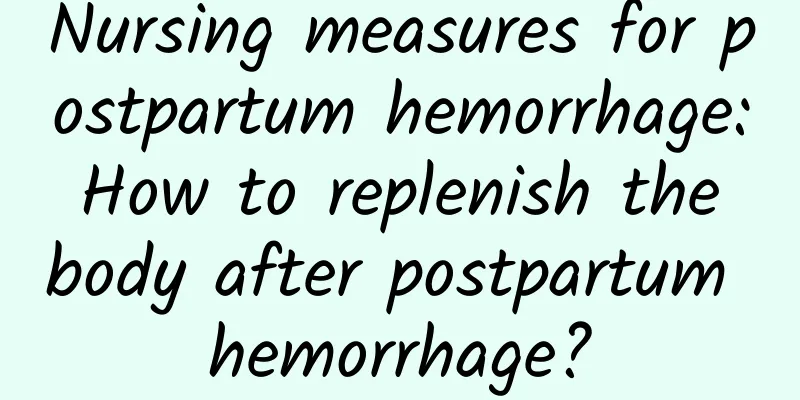Nursing measures for postpartum hemorrhage: How to replenish the body after postpartum hemorrhage?

|
Postpartum hemorrhage refers to vaginal bleeding of more than 500 ml within 24 hours after delivery, which is a common complication after delivery. Severe postpartum hemorrhage can threaten the health and life of the mother, so correct postpartum care and appropriate tonic methods are essential for the prevention and care of postpartum hemorrhage. 1. Causes of postpartum hemorrhage The causes of postpartum hemorrhage can be multifaceted, including uterine atony, birth canal injury, retained placenta, coagulation disorders, etc. Uterine atony may be due to the inability of the uterine muscles to contract effectively to stop bleeding, and birth canal injury may be caused by trauma or surgical operations during delivery. Retained placenta refers to the placental tissue that remains in the uterus after delivery, which can affect the normal contraction and recovery of the uterus. Coagulation disorders may be caused by a lack of coagulation factors or abnormal function. These factors may lead to postpartum hemorrhage, which may endanger the life of the mother in severe cases. Therefore, these causes need to be identified and treated promptly and effectively in the treatment of postpartum hemorrhage. Second, nursing measures for postpartum hemorrhage 1. Monitor bleeding. When monitoring bleeding, the amount, color, and nature of bleeding should be closely observed. Regularly record the amount of bleeding in the mother. If it is found to exceed the normal range, the doctor should be notified in time. Pay attention to whether the bleeding is accompanied by blood clots, odor, and other abnormal conditions, and take necessary nursing measures in time. Excessive bleeding in the mother may be accompanied by anemia symptoms, such as dizziness, fatigue, etc., which need to be treated in time. Correct monitoring of bleeding can help early detection and early treatment of postpartum hemorrhage and ensure the health of the mother. 2. Promote uterine contraction. After childbirth, mothers can promote uterine contraction by massaging the uterus. Pressing the uterine area and pushing upward from the lower abdomen can help stimulate the contraction of uterine smooth muscle. At the same time, mothers need to follow the doctor's advice to use uterine contraction drugs regularly to help strengthen contraction and stop bleeding. Proper promotion of uterine contraction can effectively reduce the risk of postpartum hemorrhage and promote the recovery of the mother's body. 3. Keep the mother in bed. It is very important to keep the mother in bed during postpartum hemorrhage. Bed rest can reduce the uterine pressure caused by activity, help uterine contraction and stop bleeding. The mother should try to avoid excessive activity and fatigue, maintain proper rest, and provide a good recovery environment for the mother. At the same time, a reasonable lying position can also reduce the mother's physical discomfort and pain, thereby promoting physical recovery. 3. How to replenish the body during postpartum hemorrhage? In the prevention and treatment of postpartum hemorrhage, nourishing the body is an important part. Proper nourishing can improve the physical fitness of the mother, speed up physical recovery, and thus reduce the occurrence of postpartum hemorrhage. The following are some ways to help mothers nourish their body after childbirth: 1. Dietary adjustment. Dietary adjustment is also very important in the postpartum period. Mothers should focus on a balanced diet and consume foods rich in protein, vitamins and minerals, such as fish, lean meat, beans, fresh vegetables and fruits. A moderate intake of rich dietary fiber can help regulate constipation. In addition, mothers need to drink plenty of water and maintain adequate water intake, which helps to restore physical strength and promote breast milk secretion. Reasonable dietary adjustment can provide the nutrition needed by mothers, promote recovery, and provide sufficient nutritional support for breastfeeding. 2. Chinese medicine conditioning. Chinese medicine conditioning is a common method of postpartum body conditioning. According to the mother's own situation, some appropriate Chinese medicine can be selected to promote recovery and conditioning. For example, Chinese medicine prescriptions for confinement are often used to promote uterine contraction, regulate endocrine and replenish physical strength. Commonly used Chinese medicinal materials such as angelica, astragalus, and Rehmannia glutinosa can be used in combination as needed. However, when choosing and using Chinese medicine, you should listen to the advice of professional doctors or Chinese medicine practitioners to ensure the correct use of the medicinal materials and the appropriate dosage to avoid adverse reactions. 3. Replenishing Qi and blood. It is particularly important for women to replenish Qi and blood after childbirth, which can be achieved through food and medicine. Eating more easily digestible and nutritious foods such as chicken, duck, lean meat, soy products, vegetables and fruits can help replenish Qi and blood. At the same time, some Chinese medicines such as Angelica, Codonopsis, and Chuanxiong can be used to replenish blood and Qi and promote physical recovery. When regulating Qi and blood, it is necessary to reasonably choose food and medicinal materials according to personal physical condition and doctor's advice to avoid excessive or improper adverse reactions. 4. Exercise properly. Proper exercise after childbirth is very important for replenishing qi and blood and physical recovery. You can choose some low-intensity exercises, such as walking, yoga or postpartum recovery training, which can help promote blood circulation, increase oxygen supply, and improve physical strength and metabolic rate. However, the intensity and method of exercise should be carried out according to the doctor's advice to avoid excessive fatigue and injury. Gradually increase the time and intensity of exercise, pay attention to proper rest, which will help restore body functions and enhance immunity, and accelerate the effect of replenishing qi and blood. In summary, postpartum hemorrhage is a common postpartum complication. Correct nursing measures and appropriate tonic methods are essential for preventing and treating postpartum hemorrhage. When a woman has postpartum hemorrhage, she should seek medical attention in a timely manner and follow the doctor's instructions for nursing and tonic to promote recovery and reduce the occurrence of subsequent complications. (Liu Jianxia, Lingshou County People's Hospital, Shijiazhuang City, Hebei Province) |
<<: Combining Chinese and Western medicine to prevent and treat hypertension is more effective!
>>: Nursing and prevention of cardiovascular diseases in the elderly
Recommend
I am 45 years old and my menstruation has not come yet. Should I stop menstruating?
According to a survey, the age of menopausal wome...
Could Ovulation Testing Increase Your Chances of Pregnancy?
Believe it or not, the time each month when you a...
What should I do if I have body odor during pregnancy?
Because during pregnancy, you will be more afraid...
Can I get pregnant if I have low estrogen levels?
When a woman wants to get pregnant, she must unde...
Why is Mars the second home of mankind? Does Mars have a small star?
As people's knowledge and living standards im...
The reason why women have white hair on their heads
Everyone wants their hair to be black, because bl...
Introduction to treatment of endometriosis
The most terrifying thing for women is the occurr...
How to facilitate the discharge of the gestational sac
Some women are forced to have miscarriages due to...
What is the reason for leucorrhea to become tofu dregs?
Many women suffer from gynecological diseases, wh...
How much does a salpingogram cost?
For women with infertility, they usually have to ...
Counterpoint: Samsung's global foldable screen shipments plummeted 42% year-on-year in Q1 2024
Samsung, which once had an absolute advantage in ...
Quick pain relief for menstrual cramps
We often call the menstrual period that women hav...
Why are my allergy symptoms so severe but cannot be diagnosed?
Diagnosing allergies depends not only on immunolo...
Can girls grow taller by drinking milk?
Many people usually want to increase their height...
Sore arms and legs during early pregnancy
In the early stages of pregnancy, women are very ...









